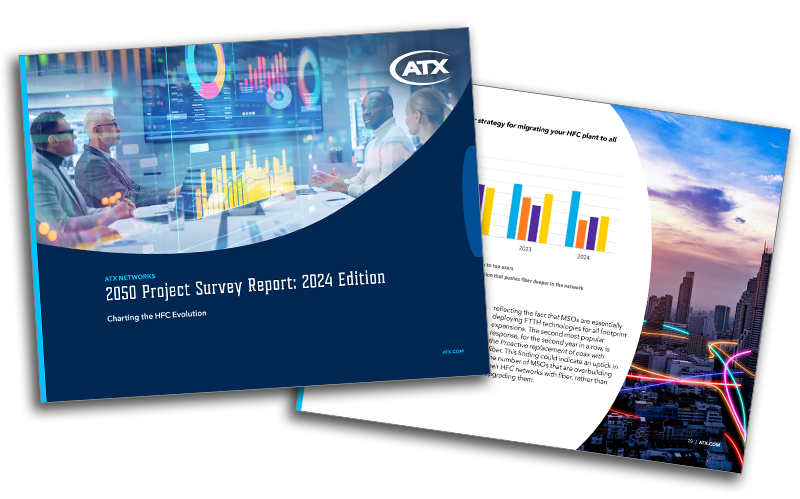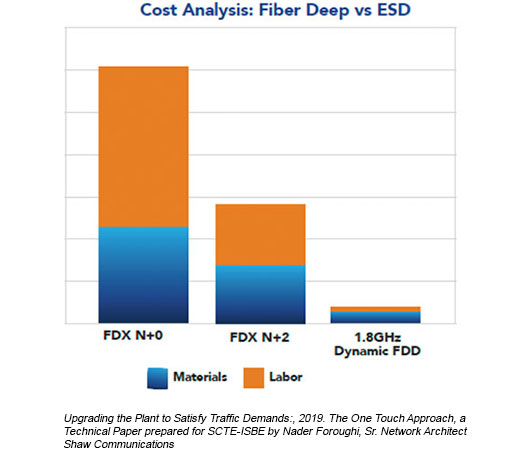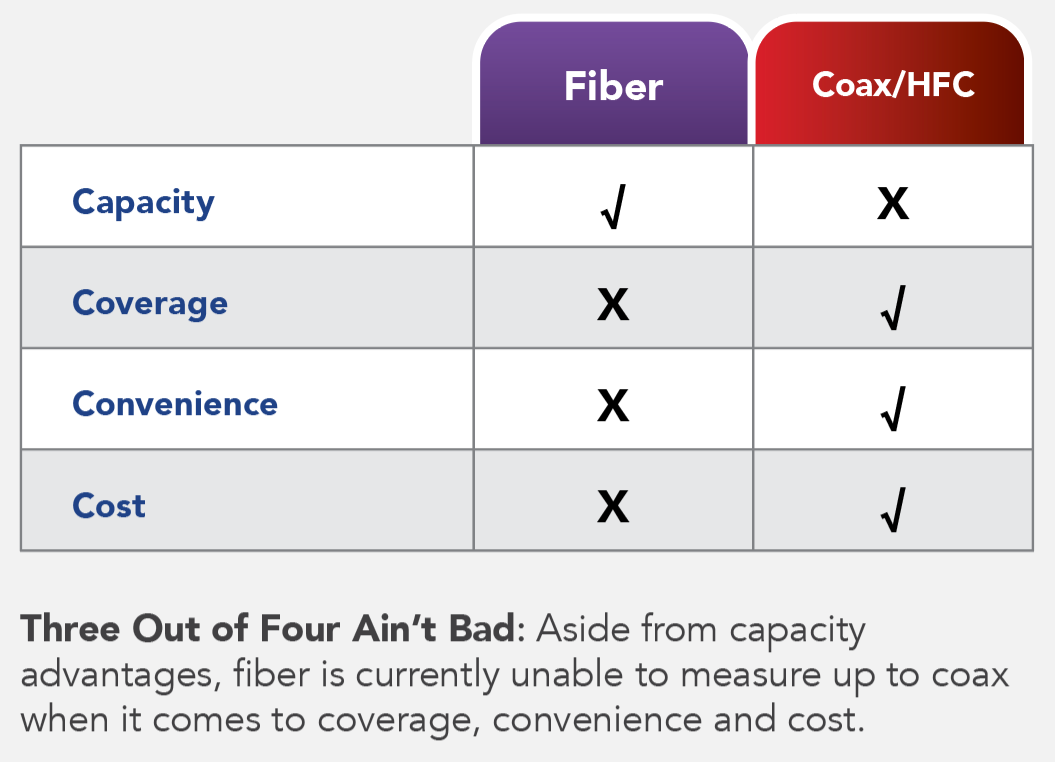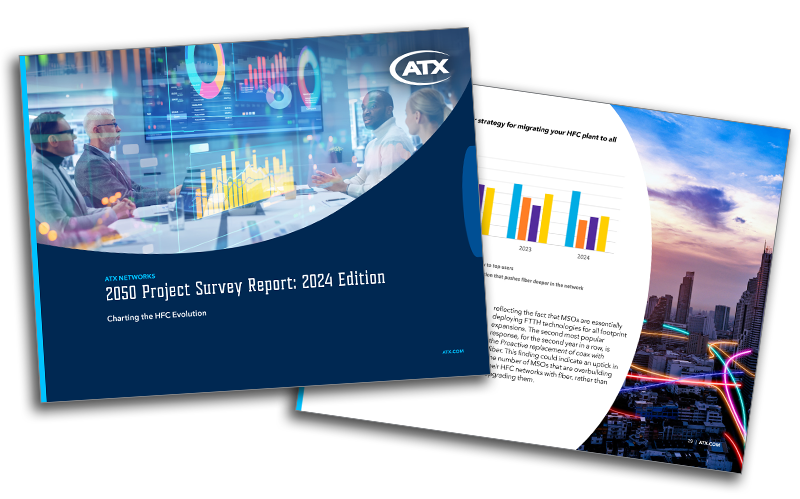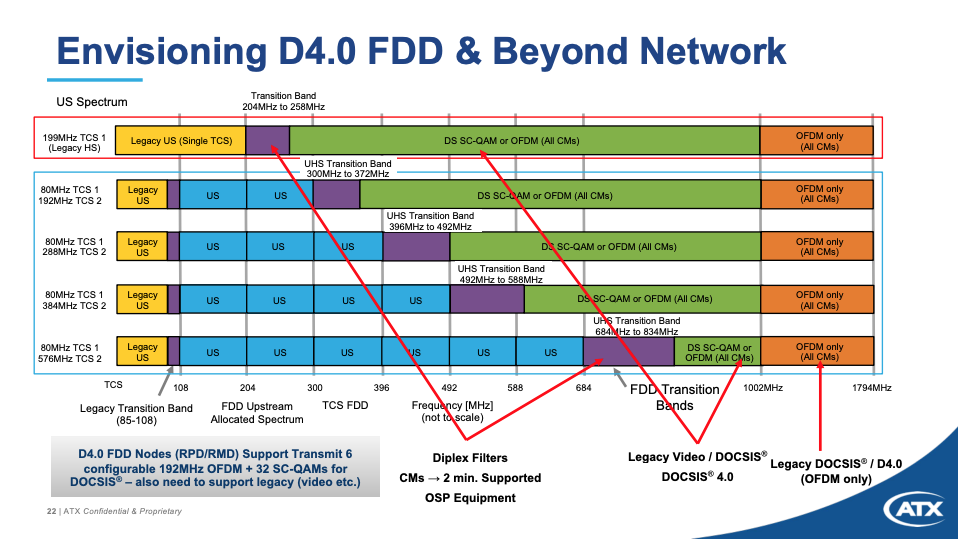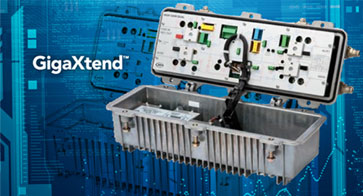The 2050 Project
Let’s Get Started
The installation of the first fiber nodes in the cable access plant in the early 1990s gave birth to the Hybrid Fiber-Coax network. What seemed like an inauspicious event at the time, turned out to be the launch date of the world’s most robust and resilient infrastructure for the delivery of broadband services. Thirty years later, the HFC network remains without rival in reach, reliably and agility — better able to react to fluctuations in traffic rates and consumer bandwidth demands than any other broadband medium. The 2050 Project is a long-term outside plant evolution initiative from ATX that provides cable operators with a roadmap for doubling the longevity of their HFC networks.
The 2050 Project is also ATX’s commitment to assisting MSOs with the migration of their massive coaxial cable plants to fiber in the most cost-effective manner possible and without surrendering their dominance in broadband service delivery.
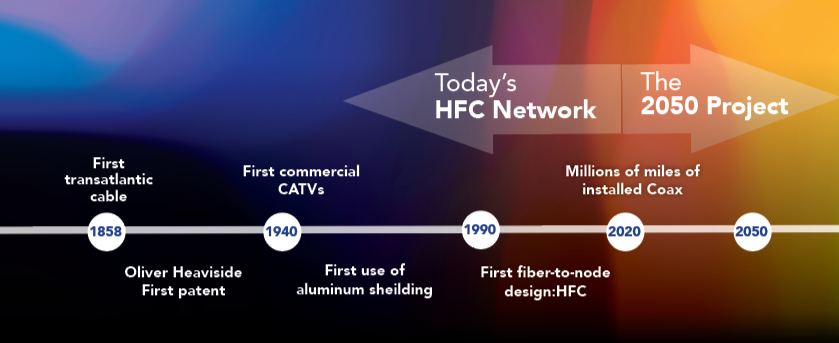
This site contains everything you need for a complete understanding and exploration of the 2050 Project, including links to thought-leadership white papers, surveys, webinars, news articles and information about innovative products that offer MSOs the agility to start building their networks of the future today.
The 2050 Project Fact File
Definition: Vision and strategic game plan that MSOs can follow to double the longevity of their current networks
Objective: Stretch out HFC investment for 25 years and longer to better absorb costs of migrating to an all-fiber network
Benefits:
Think Big
GO LONG
Fiber is the future. But replacing millions of miles of coax will take decades – and cost billions. The only way MSOs can manage the long-term migration to an all-fiber infrastructure without falling behind competitively is through incremental boosts of bandwidths to customers served by HFC networks. A two-part information series from ATX offers MSOs a game plan for fending off a variety of competitive threats and insights into the best way to evolve their network to meet the communications requirements of the next several decades. It also offers an element-by-element evaluation of the readiness of current HFC infrastructures to support frequency upgrades beginning at 1.8GHz.
Sticker Shock
Although MSOs are perpetually adding fiber to their HFC networks, evolving the HFC network remains a cost-effective alternative to fiber buildouts. The chart below illustrates the relative cost differences between moving to a Node+0 or even a Node+2 architecture to achieve additional capacity versus extending spectrum to 1.8GHz using the FDD version of DOCSIS 4.0. This chart is from a 2019 white paper, Upgrading the Plant to Solve Traffic Demands, presented by a Shaw Communications engineer at the SCTE Tec-Expo Conference.

Is Coax Capable?
Coaxial cable is a modern marvel that originated in the 19th century. Its ironclad design made it the logical choice for the first transcontinental cable, way back in 1858. Since then, cable operators have threaded millions of miles of coax into neighborhoods around the world. Just one U.S. MSO alone estimates that it manages 750,000 miles of coax. That’s enough to circle the Earth about 25 times! Still, the reality is that nearly 99% of the HFC network is fiber, with coax making up the last mile. While replacing the coax network is the endgame of MSOs, the robustness of that medium buys them ample time — a couple decades or more — to migrate those endpoints to fiber. From an economic and customer disruption perspective, it makes little sense to proactively rip out an infrastructure that is more than capable of supporting the multigigabit speeds that 10G promises. And from a sustainability perspective, upgrading the HFC network, rather than overbuilding it, is by far the planet-friendly choice. Doing so eliminates the need to immediately dispose of millions of pounds of discarded coaxial cable or fire up the fossil-fuel-burning machinery required to build out fiber networks. Read the below blogs to get a better understanding of MSOs’ relationships with fiber and why they view DOCSIS 4.0 as their secret sauce for fending off threats from FTTH operators for decades to come.
2050 Project: The Survey
On a mission to capture first-hand knowledge of cable operators’ plans for evolving their HFC networks, ATX Networks launched its first HFC Evolution Survey in 2021, issuing a follow-up report the following year. Findings from the third Edition of the 2050 Project Survey were released in the first half of 2023. The fourth and most recent edition of the 2050 Project Survey Report reflects the opinions of nearly 150 cable professionals, the biggest universe of participants in the survey’s history. This year’s report, similar to previous editions, contains more than 30 charts that document how MSO attitudes and deployment plans have changed from just a year ago – and previous years. Nothing beats knowing what your peers are planning and the 2050 Project Survey Report is the industry’s only source for tapping into the long-term technology adoption strategies of cable operators across the globe.
Bandwidth:
THE INSATIABLE QUEST
It is said that you can never be too thin or have too much money. An axiom that might be more relevant to MSOs is the truism that you can never have too much bandwidth. The high-speed broadband pipe, regardless of how broad, is one that is destined to fill up. Technologists can only speculate about how much bandwidth will be required to deliver the Matrix-like communications environments that futurists are predicting over the next several decades, or the capacity needed to support the total transition of major industries, such as medicine and education, to the digital realm. Peruse the below collateral for a more detailed look at what a not-too-distant communications future might look like.
Buckets of Bandwidth: The 2050 Technology Landscape

Next Technologies
The Millennium Project, a voluntary think tank of futurists, scholars, scientists, business planners and policy makers have identified “next technologies” that will be prevalent in 2050, including:
- Synthetic Biology
- IoT
- Human Augmented Intelligence
- Telepresence
- Holographic Communications

Tech Predictions
- Nanobots will plug human brains into cloud
- People reincarnation through AI Intelligence
- IoT technology will change product design
- Self-driving cars will make driving safer
- Smartphones will have been obsolete for 25 years
- Most human interaction will happen in virtual reality

4th Industrial Revolution (Davos 2019)
- A blurring of lines between physical, biological and digital spheres
- Robots
- Voice-activated assistants
- Facial ID recognition
- Digital healthcare sensors
White paper: Welcome to The Gigabit Generation
Discover why Gigabit broadband will be a catalyst for a digital makeover of entire industries
Blog: Are Cable Operators Ready for the Metaverse?
Learn MoreBlog: Welcome to the The Golden Age of Broadband
Learn MoreHybrid Fiber-Coax:
THE NEXT 30 YEARS
Given future bandwidth demands, MSOs have already charted out a path for boosting the speed of both the upstream and downstream channels of the HFC network to nearly 10Gbps. The CableLabs 10G Initiative, introduced in 2019, was already largely validated in a speed test conducted by Charter Communications at the end of April 2022 and again at the fall SCTE Cable-Tec Expo. A prototype network, featuring 2GHz taps from ATX Networks, recorded downstream speeds of 8.9Gbps. Read the blog at the end of this section to relive and celebrate this monumental milestone.
An open question that likely won’t be answered for a decade or more is What happens after 10G? The current version of DOCSIS specifications, DOCSIS 4.0, call for extending the frequency of the existing HFC network to 1.8GHz, which will support download speeds of 10Gbps and upload rates of roughly 6Gbps. Whether cable operators cap their HFC networks at 1.8GHz before moving to all-fiber or extend their infrastructures to 3GHz or higher is dependent on several factors. Current indications, however, point to 1.8GHz as the likely spectrum high mark of the HFC network, a topic captured in the below blog.
| Evolution of the HFC Network | The First 30 Years | The Next 30 Years |
|---|---|---|
Optics |
Analog | Digital |
Spectrum Maximum |
1.2GHz | 3GHz+ |
Bandwidth Span |
56Kb to 1Gb | 1Gb to 50Gb |
Technology Lifecycle |
8-10 years | 25 or more years |
Architecture |
CAA | DAA |
Typical Applications |
Email, streaming video | Holodecks, telemedicine |
Ready-Set-Evolve
Even though the mid-century mark is almost 30 years away, MSOs can immediately start building out their next-gen HFC networks. Before you break ground, though, why not do a little prep work? For a complete rundown of what you’ll need to get your 2050 Project off the ground, watch the webinar The 2050 Project: A New Era of Outside Plant Evolution. It’s an A-to-Z exploration of what MSOs should be thinking about, in terms of products, roadmaps and best practices, as they begin to plot out the futures of their HFC plants.
Agile Innovation
If you’re constructing a network today that will still be relevant in 2050, you better start with building blocks that are adaptable to incremental increases in spectrum and that can be upgraded with a minimal number of truck rolls. ATX’s GigaXtend™ family of next-gen outside plant equipment is built for the long haul. The most agile outside plant portfolio on the market, GigaXtend is designed to evolve with market demand and reduce respacing to a minimum.
Press Release: ATX Networks to Showcase 1.8GHz HFC Amp Portfolio at Cable-Tec Expo 2022
Learn MoreBlog: How ATX is Helping Build a Broadband Cathedral
Learn MoreThe GigaXtend GMC Series amplifier portfolio is built on a trusted and well-regarded technology foundation, providing ATX with the opportunity to offer cable operators a seamless evolutionary path to spectrum ranges of 1.8GHz, 3GHz and higher.
Learn MoreThe GigaXtend™ family of taps injects immediate cost and performance benefits into existing HFC networks, as well as positions cable operators to seamlessly extend the bandwidth capabilities of their HFC networks to 2GHz and beyond.
Learn MoreAccept No Substitutes
Knockoff versions of authentic products are everywhere, and it’s always wise to be wary of sales pitches that start off with “Pssst.” ATX entered a licensing agreement with Cisco® in early 2020 and remains the only maker of authorized GainMaker®-compatible amplifiers. Read the blog to better understand why you should accept no substitutes when it comes to imitation GainMaker-compatible amplifiers.
In The News
"ATX adds US manufacturing for HFC network upgrade wave"
ATX Networks is about to launch new US-based manufacturing to loosen supply chain constraints and ramp up production of amplifiers and other outside plant equipment that will underpin the cable industry’s coming wave of network upgrades […]
VIEW ONLINE ARTICLE"ATX: Nearly Half of Cable COs will Upgrade to DOCSIS 4.0 by End of 2025"
Cable operators are eager to take advantage of the forthcoming DOCSIS 4.0 rollout, as a survey from ATX Networks found nearly half (48%) of cable companies plan to activate DOCSIS 4.0 in their hybrid-fiber coaxial (HFC) networks by the end of 2025 [...]
VIEW ONLINE ARTICLE“Changing the HFC vs. fiber discussion could help cable MSOs, says ATX chief”
ATX Networks recently released the results of an annual survey of cable MSOs that revealed strong support for upgrading HFC infrastructure rather than overbuilding their footprint with fiber to the premises [...]
VIEW ONLINE ARTICLE
